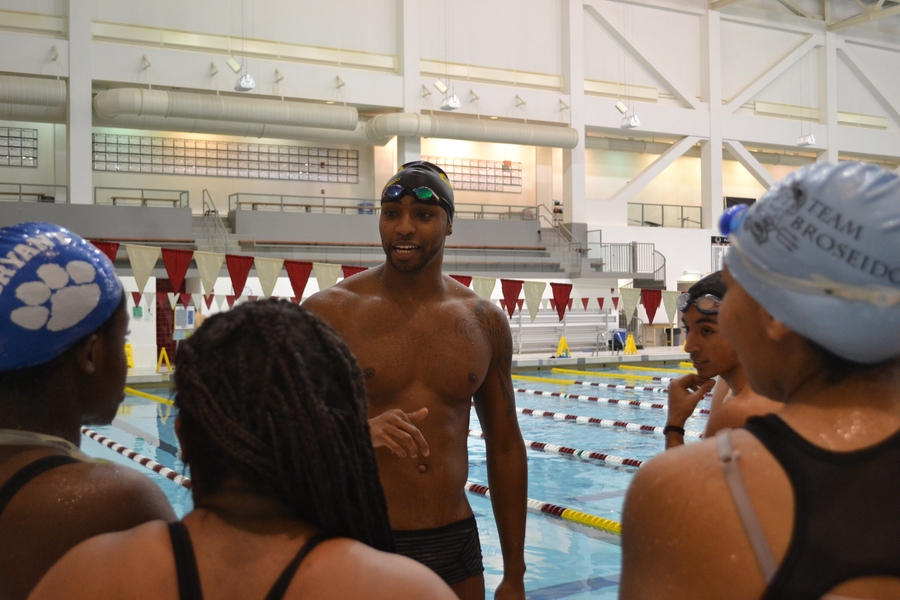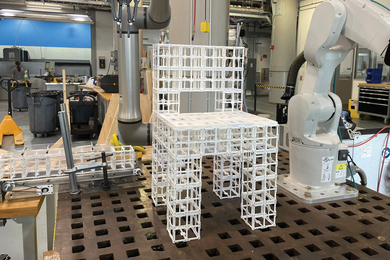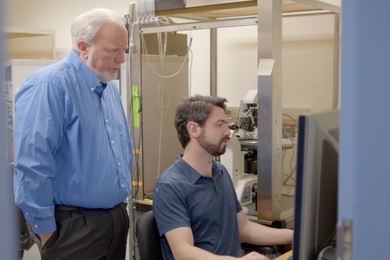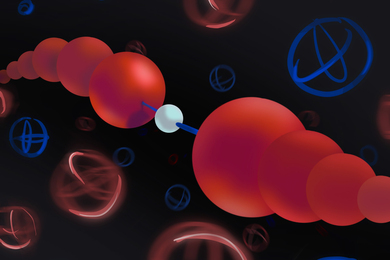Taking part in relays, recounting stories from his past, posing for pictures, and making up cheers, U.S. Olympic swimmer Cullen Jones seemed to be having just as good a time as the members of MIT's Amphibious Achievement program at MIT’s Zesiger Center Pool on Saturday.
As the winner of the USA Swimming Foundation’s “A Picture Is Worth a Thousand Words” photography contest, Amphibious Achievement, a dual athletic and academic mentorship program for inner-city students in Greater Boston, received a visit from the two-time Olympic gold medalist who held a two-hour workshop with the high school students at before challenging them to a relay race in the pool. This contest was part of the foundation’s Make a Splash Tour.
The Make a Splash campaign, launched in 2007 by the USA Swimming Foundation, is a water safety initiative that is raising funds to provide every child in the U.S. with swim lessons. The foundation also partners with different groups to educate the public about drowning.
Jones decided to become involved with the USA Swimming Foundation after learning that the second leading cause of accidental death in children under 14 in the U.S. is drowning. “People don’t know that because it’s not in everyone’s faces every day,” Jones says. “After I won my first gold medal, a friend of mine showed me drowning statistics, and I knew that this was something I wanted to be a part of. I knew right then that I could give back to a sport that had given me so much.” Jones has partnered with the Make a Splash campaign since 2008.
Before getting in the water with the Achievers, Jones met with the students to talk about his journey to Olympic gold. “A lot of it was my own story, the goods and the bads, everything,” Jones says. “The pitfalls are the things that people need to understand. It’s not all about the gold medals. There have been moments I have struggled. I grew up in the inner city and never believed I would become an Olympian.”
Jones also discussed the importance of having dreams and goals with the Achievers. “Swimming has taught me about goal-setting,” Jones says. “It has taught me that nothing comes easy. Every day that I go to practice, I know that I am training to take seconds off my time. I train for hours, weeks, months, just to drop a tenth of a second. It’s frustrating, but at the same time, I love it.”
Amphibious Achievement was launched in 2011 by MIT student-athletes Noam Angrist ’13 and Ron Rosenberg ’13. The program, which focuses on promoting “success in and out of the water,” has tripled in size since it began just two years ago. With 40 MIT mentors and 55 Achievers, the group meets every Sunday to work on swimming and rowing techniques, math fundamentals, and critical reading. Students in their junior and senior years receive help with college applications and essays.
Since becoming the face of the Make a Splash initiative, Jones has traveled all over the country to meet with groups similar to Amphibious Achievement. “Traveling to meet new kids is an amazing, amazing privilege. Just to see so many different children from all different walks of life, some good, some absolutely awful, is what makes it worth it. Some kids don’t have suits and goggles, and the scariest thing isn’t that they don’t have them — it’s that they don’t even know they need them. It’s cool to be able to shine a light on such a problem and expose these children to something they never even thought possible.”
As the winner of the USA Swimming Foundation’s “A Picture Is Worth a Thousand Words” photography contest, Amphibious Achievement, a dual athletic and academic mentorship program for inner-city students in Greater Boston, received a visit from the two-time Olympic gold medalist who held a two-hour workshop with the high school students at before challenging them to a relay race in the pool. This contest was part of the foundation’s Make a Splash Tour.
The Make a Splash campaign, launched in 2007 by the USA Swimming Foundation, is a water safety initiative that is raising funds to provide every child in the U.S. with swim lessons. The foundation also partners with different groups to educate the public about drowning.
Jones decided to become involved with the USA Swimming Foundation after learning that the second leading cause of accidental death in children under 14 in the U.S. is drowning. “People don’t know that because it’s not in everyone’s faces every day,” Jones says. “After I won my first gold medal, a friend of mine showed me drowning statistics, and I knew that this was something I wanted to be a part of. I knew right then that I could give back to a sport that had given me so much.” Jones has partnered with the Make a Splash campaign since 2008.
Before getting in the water with the Achievers, Jones met with the students to talk about his journey to Olympic gold. “A lot of it was my own story, the goods and the bads, everything,” Jones says. “The pitfalls are the things that people need to understand. It’s not all about the gold medals. There have been moments I have struggled. I grew up in the inner city and never believed I would become an Olympian.”
Jones also discussed the importance of having dreams and goals with the Achievers. “Swimming has taught me about goal-setting,” Jones says. “It has taught me that nothing comes easy. Every day that I go to practice, I know that I am training to take seconds off my time. I train for hours, weeks, months, just to drop a tenth of a second. It’s frustrating, but at the same time, I love it.”
Amphibious Achievement was launched in 2011 by MIT student-athletes Noam Angrist ’13 and Ron Rosenberg ’13. The program, which focuses on promoting “success in and out of the water,” has tripled in size since it began just two years ago. With 40 MIT mentors and 55 Achievers, the group meets every Sunday to work on swimming and rowing techniques, math fundamentals, and critical reading. Students in their junior and senior years receive help with college applications and essays.
Since becoming the face of the Make a Splash initiative, Jones has traveled all over the country to meet with groups similar to Amphibious Achievement. “Traveling to meet new kids is an amazing, amazing privilege. Just to see so many different children from all different walks of life, some good, some absolutely awful, is what makes it worth it. Some kids don’t have suits and goggles, and the scariest thing isn’t that they don’t have them — it’s that they don’t even know they need them. It’s cool to be able to shine a light on such a problem and expose these children to something they never even thought possible.”






